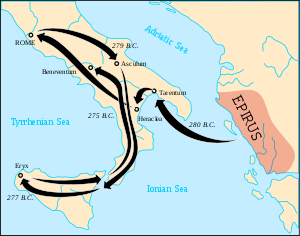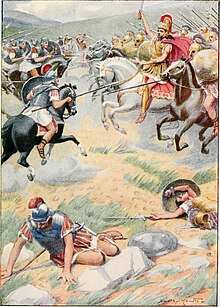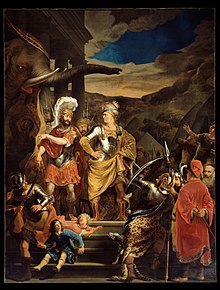Battle of Heraclea
This article has multiple issues.Please helpimprove itor discuss these issues on thetalk page.(Learn how and when to remove these template messages)
|
| Battle of Heraclea | |||||||
|---|---|---|---|---|---|---|---|
| Part of thePyrrhic War | |||||||
 Battle sites and places of the Pyrrhic War | |||||||
| |||||||
| Belligerents | |||||||
|
Epirus Magna Graecia | Roman Republic | ||||||
| Commanders and leaders | |||||||
| Pyrrhus | Publius Valerius Laevinus | ||||||
| Strength | |||||||
|
35,500 men
|
45,000 men
| ||||||
| Casualties and losses | |||||||
| 4,000–11,000 killed |
7,000–15,000 killed 1,800 captured | ||||||
TheBattle of Heracleatook place in 280 BC between theRomansunder the command ofconsulPublius Valerius Laevinus,and the combined forces ofGreeksfromEpirus,Tarentum,Thurii,Metapontum,andHeracleaunder the command ofPyrrhus,king of Epirus. Although the battle was a victory for the Greeks and their casualties were lower than the Romans, they had lost many veteran soldiers that would be hard to replace on foreign soil.[3]
Background
[edit]Tarentum was aGreek colony,part ofMagna Graecia.The members of the leading faction in Tarentum, thedemocratsunder Philocharis or Ainesias, were against Rome, because they knew that if the Romans entered Tarentum the Greeks would lose their independence. The Greeks in Tarentum had grown afraid of Roman expansion after theThird Samnite War.After the surrender of theSamnitesin 290 BC, the Romans founded many colonies inApuliaandLucania,the most important of which wasVenusia.In 282 BC, after a battle against the Samnites,Lucanians,BruttiansandThurii,Roman troops entered the Italian Greek colonies ofCroton,Lokroi,andRhegium.Democrats from Tarentum knew that as soon as Rome finished its war with theGauls,Lucanians,Etruscans,Samnites,andBruttians,they would enter Tarentum. Another event that concerned the Tarentines was that the aristocratic faction of Thurii that had taken power had invited a Roman garrison into their city; the Tarentines, who had been the referents of all theMagna Graeciacolonies, were deeply worried about this fact.
The second faction in Tarentum were the aristocrats, led by Agis, who did not oppose surrendering to Rome, as it would lead to the return of the aristocratic faction to power. The aristocrats, however, could not surrender directly and become unpopular with the population. In the autumn of 282 BC, Tarentum celebrated their festival ofDionysus;while in their theatre in front of sea, they saw ten Roman ships, with soldiers and supplies for the Roman garrison of Thurii, entering theGulf of Taranto.According to Kęciek, the Tarentine aristocracy asked the Roman commanders Publius Cornelius and Lucius Valerius to arrest and execute the democrats and their followers, which would allow the aristocrats to surrender. The Tarentines were angry, because the Romans had signed an agreement not to sail into the Gulf of Taranto, and they prepared their navy to attack the Roman ships. A few of the ships were sunk, and one was captured.
The Tarentines knew that they had few chances of victory against Rome. They decided to call for help from Pyrrhus, King ofEpirus.The army and fleet of Tarentum moved to Thurii and helped the democrats there exile the aristocrats. The Roman garrison placed in Thurii withdrew.
The Romans sent a diplomatic mission to settle the matter and take back the prisoners but the negotiations ended abruptly, so Rome declared war on Tarentum. In 281 BC, Roman legions under the command ofLucius Aemilius Barbulaentered Tarentum and plundered it. Tarentum, with Samnite and Salentine reinforcements, then lost a battle against the Romans. After the battle theGreekschose Agis to sign a truce and begin diplomatic talks. These talks were also broken off when 3,000 soldiers from Epirus under the command of Milon entered the town. The Roman consul withdrew and suffered losses from attacks by the Greek ships.
Pyrrhus decided to help Tarentum because he was in debt to them — they had earlier helped him conquer the island ofCorcyra.He also believed that he could count on help from the Samnites,Lucanians,Etruscans,Umbrians,andBruttians,and someIllyriantribes, all peoples with a history of conflict with Rome. His ultimate goal was to re-conquerMacedonhe had lost in 285 BC, but did not have enough money to recruit soldiers. He planned to help Tarentum, then go toSicilyand attackCarthage.After winning a war against Carthage and capturing south Italy he would have enough money to organise a strong army and capture Macedon.
Preparation
[edit]Before he leftEpirus,Pyrrhus formed an alliance and borrowed soldiers and money from the pretender to the Macedonian throne,Ptolemy Keraunos.His long-time friend and allyPtolemy II Philadelphus,king ofPtolemaic Egypt,also promised to send 9,000 soldiers and 50war elephants.He also recruited cavalry fromThessalyand archers and slingers fromRhodes— as their rulers wanted to avoid a war with Epirus. In the spring of 280 BC Pyrrhus landed without losses in Italy.
After hearing of Pyrrhus' arrival in Italy the Romans mobilized eight legions with auxiliaries, totalling about 80,000 soldiers. They divided it into four armies:
- One army under the command ofBarbula,with orders to distract the Samnites and Lucanians so they could not join Pyrrhus' army. They were placed in Venusia.
- A second army left behind to secure Rome.
- A third army under the command of consulTiberius Coruncaniusmarched against Etruscans, to avoid an alliance between them and Pyrrhus.
- A fourth army under the command of Publius Valerius Laevinus marched toTarentum.They also plundered Lucania.
Publius Laevinus moved towardsHeraclea,a city founded by the Tarentines, with the intention of cutting Pyrrhus off from the Greek colonies of Calabria, thus avoiding their uprising against Rome.
Armies and Order of battle
[edit]This is a possible order of battle for Heraclea.[4]
Epirus
[edit]Commander: Pyrrhus
- 3,000hypaspistsunder Milon command
- 20,000phalangites,Epirotesincluding 5,000 Macedonian soldiers given by Ptolemy
- 6,000 Tarentine levyhoplites
- 4,000 horsemen, including the Thessalian contingent and 1,000 Tarentine horsemen
- 2,000 archers
- 500 Rhodianslingers
- 20 war elephants with towers holding troops.
Roman Republic
[edit]The disposition of the troops of the Roman Republic hypothesized:[5][6]
Commander: Publius Valerius Laevinus
- Infantry: Approximately 8 legions[7][8]divided into:
- Cavalry; two different accounts:
- Other sources put the cavalry at 6,000 total composed as follows:
- Roman Cavalry 1200
- Allied Legion Cavalry 3600
- Southern Italian Cavalry 1200 (Light Cavalry)[2]
Battle
[edit]
Pyrrhus did not march against the Romans while he was waiting for his allies' reinforcements. When he understood that reinforcements were not coming, he decided to fight the Romans on a plain near the riverSiris(modernSinni), betweenPandosiaand Heraclea. Pyrrhus took up position there and waited. Before the fight he sent diplomats to the Roman consul, proposing that he could arbitrate the conflicts between Rome and the population of southern Italy. He asserted that his allies recognised him as a judge and demanded the same recognition from the Romans. The Romans denied his request, and entered the plain on the right of the Siris river, where they set up camp.
It is unknown how many troops Pyrrhus had left in Tarentum, it is estimated he had about 25–35,000 troops with him at Heraclea. He took up position on the left bank of the Siris, hoping that the Romans would have difficulty crossing the river, which would allow him more time to prepare his attack. He set up somelight infantryunits near the river to let him know when the Romans began to cross, and planned first to attack them with his cavalry and elephants. Valerius Laevinus had about 42,000 soldiers under his command, including cavalry, velites, and spearmen. It would be the first time in history that two very different juggernauts of war clashed: theRoman Legionand theMacedonian Phalanx.
At dawn, the Romans started to cross the river Siris. On the flanks the Roman cavalry attacked the scouts and light infantry, who were forced to flee.
When Pyrrhus learned that the Romans had begun crossing the river, he led his Macedonian and Thessalian cavalry to attack the Roman cavalry. His infantry, with peltasts and archers and heavy infantry, began their march as well. TheEpirotecavalry successfully disrupted the Roman battle formation and then withdrew. Pyrrhus' peltasts, slingers, and archers began to shoot and hissarissa-wielding phalanxes began to attack. Theinfantryline was near equal to the Romans' in length as, although Pyrrhus had a small advantage in number, the phalanx was by design deeper than the legion.
The phalanxes made seven attacks, but failed to pierce the legion. It had met a foe that was stronger than any it had ever encountered. The Romans made seven attacks, yet they could not break the phalanx, and the battle hung in the air. At one point, the battle became so pitched that Pyrrhus—realizing that if he were to fall in combat, his soldiers would lose heart and run—switched armor with one of his bodyguards. This bodyguard was subsequently killed, and word spread through the ranks that Pyrrhus had fallen. His force began to waver, and the Romans gave a thunderous cheer at the turn of events. Grasping the magnitude of the situation, Pyrrhus rode forward, bare-headed, along the lines of his men to show he was still living. This show of bravery strengthened their resolve. A massive cheer went up from the Greek line, and the battle raged on.
Unable to make any significant gains in action, Pyrrhus deployed his war elephants, held in reserve until now. The Roman cavalry was threatening his flank too strongly. Aghast at the sight of these strange and brooding creatures which none had seen before, the horses galloped away and threw the Roman legion into rout. (The Romans subsequently called elephantsLūca bōs,'Lucanian ox', after the location of this first encounter.). Pyrrhus then launched his Thessalian cavalry among the disorganized legions, which completed the Romans' defeat. The Romans fell back across the river and Pyrrhus held the field.
In the opinion of Dionysius, the Romans lost 15,000 soldiers and had thousands taken prisoner; Hieronymus states 7,000. Dionysius totalled Pyrrhus' losses at around 11,000 soldiers, 3,000 according to Hieronymus. Either way, this could be considered the earliest of hisPyrrhic victoriesagainst Rome.
Aftermath
[edit]
After the battle, reinforcements from south Italy joined Pyrrhus. The Greeks of Rhegium who wanted to join him were massacred by Roman soldiers under the command of Decius Vibelius, who was proclaimed ruler of the town. Pyrrhus then began to march towards Rome. He captured many small towns inCampania,and his forces plunderedLatium.His march was stopped inAnagni,two days from Rome, when he met the other Roman consular army underTiberius Coruncanius.Pyrrhus was afraid that he did not have enough soldiers to fight, and knew Laevinus and Barbula were probably marching behind him. Instead he withdrew and the Romans did not follow him.
See also
[edit]Notes
[edit]- ^Nicholas Hammond, Epirus: The Geography, the Ancient Remains, the History and Topography, Clarendon P., 1967
- ^abcd"Heraclea".
- ^Legion Versus Phalanx, Myke Cole
- ^Jonas, Jeff,"The Initial Clash: Republican Rome vs. Pyrrhus of Epirus",AncientBattles.com, January 20, 2007. Retrieved on July 24, 2009.
- ^The data are based on the theoretical consistency of 4,200 legionaries and 300 Roman knights to legion.
- ^(in English)Jeff Jonas,The Initial Clash: Republican Rome vs. Pyrrhus of Epirus
- ^Piganiol, p. 183
- ^Brizzi, p. 127
- ^Livy(Ab Urbe seasoned books,VIII, 8, 14) writes that the legions were composed of 5,000 infantry and 300 cavalry at the time ofLatin War.
- ^abPolybius VI, 20, 8-9.
- ^abP. Connolly, pp. 10-11.
- ^Polybius VI, 26, 7.
References
[edit]- Kęciek, Krzysztof,Benewent 275 p.n.e,Bellona, Warsaw, 2001.
- Information about this war can be found inPlutarch'sLives,Polybius,Dionysius of Halicarnassus,andLivy.
